Customer experience insights to innovation
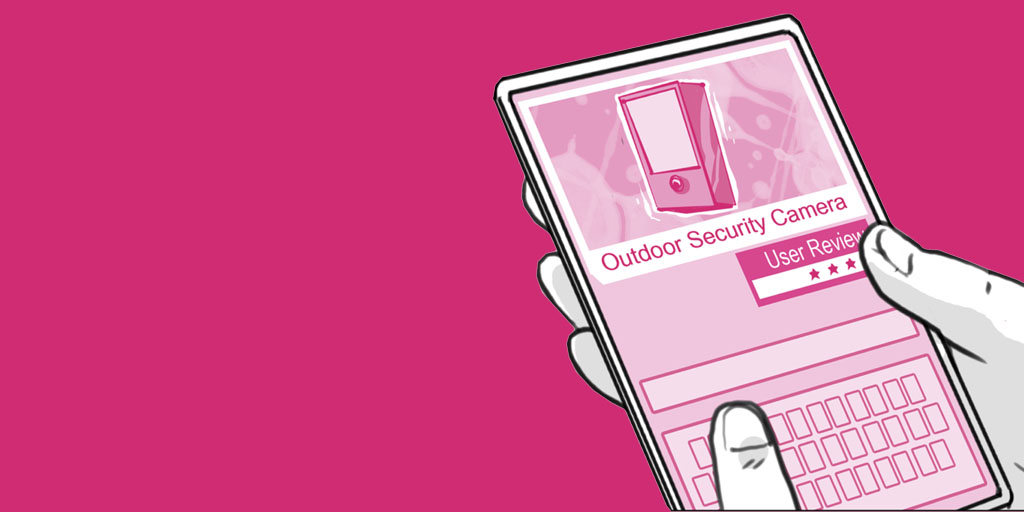
Customer experience insights to innovation Deutsche Telekom (Germany, Greece, Hungary, Slovakia) Share Experientia has been commissioned by Deutsche Telekom to conduct multiple research activities aimed at envisioning opportunities for new products and services development with diverse time horizons. 3 things to know Improve Deutsche Telekom customer’s home experience Expand upon the range of Deutsche Telekom clients and reshape its existing customer home business. Multi-horizon innovation strategy Identify new business opportunities both for incremental innovation and as opportunities around future needs and trends. Design best practice guideline for CX research Involve internal stakeholders and share project outcomes as a strategic roadmap for innovation research at Deutsche Telekom. Gallery User scenarios User scenarios Insights clustering Workshop day Workshop day In depth Service mix: Design thinking Participatory design Service design Ethnography Useful links: Link External link Context Since home consumer behaviors and needs change over time influenced by various factors such as technological advancements, economic conditions, cultural trends, and individual preferences it is important to keep and a human-centered approach in order to understand if we are addressing the evolving needs and expectations and understanding how to improve existing experiences and design new ones also in the long term. Challenge Identify customer experience strategy that evolves home consumer business opportunities and improves customer experience. Research Experientia has started by conducting stakeholder interviews and hypothesis workshop to define research directions and align with Deutsche Telekom stakeholders. Social media listening activity has coupled with a market and trend research to understand macro phenomenon and identify weak signals, emerging practices and major trends that may have local impact. Expert interviews have been conducted to understand their perspective of the changing customer needs, while in-home customer and lead user interviews helped to understand users behavior and observe emerging behaviors respectively. Design Experientia has analyzed the emerging research information and identified relevant insights. The interview insights have been prioritized using customized analysis-based design tools. Thematic insights have helped to identify moments that matter during customer experience. This information has determined a relevant impact in problem reframing and subsequently in creating initial opportunities, that serves as a basis to shape innovative concepts and value propositions for improving existing experience and shaping new solutions. Impact Experientia created 10 innovative concept value propositions that include added value for current CX, products, service and future products and services experiences. for improving customer experience to successfully defend/reshape business efforts and increase footprint in the homes and minds of Deutsche Telekom customers. Link External link Related projects All Services Behavioral design Research and assessment Strategy Consumer technology Buttonless: engaging users in interactions with keyless devices Brand UXConsumer technology European car aesthetics: Unveiling preferences and values Brand UXConsumer technology Mobile Privacy UX Go back to our portfolio
Mobile Privacy UX
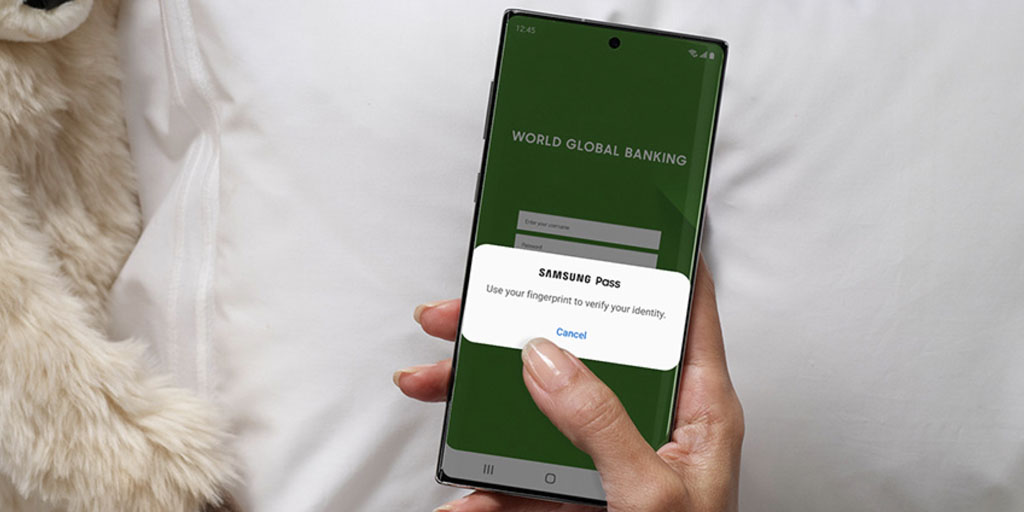
Mobile Privacy UX Samsung (South Korea) Share Experientia has worked for Samsung Electronics on a wide variety of projects since 2005 that covered different phases of their design process. This project was commissioned from Samsung South Korea and aimed to understand how users interpret privacy, both from a wide and narrow perspective, in order to support Samsung in the design of new privacy-related products and services. 3 things to know What users are talking about when they say “Privacy” For people privacy is an important good in itself.Privacy concerns are higher in a mobile ecosystem; to overcome this issue, companies have to rely on the trust that people grant them, and should aim to build stronger user confidence. Security and Privacy are different breeds The tech community has pushed a narrative where privacy is articulated as data security, which in turn gets translated in settings and features. This is challenging for people. Being comfortable with one’s own data What people share in the digital environment is tightly associated with the perceived risk of this action. The seriousness of risk is identified by two dimensions: the perceived distance of data disclosure consequences, and the affinity to people’s daily lives. Gallery What people share in the digital environment is tightly associated to the perceived risk of this action. How competitors address privacy Our approach Opportunity map In depth Service mix: Design thinking Ethnography Useful links: Link External link Context People who care about their privacy often feel that they are “forced” to disclose personal data, and are concerned that they don’t really know what they are really disclosing. To map this better, it’s important to start with the acknowledgement that peoples’ notions of privacy often differ significantly from how the industry and media approach this subject. Challenge Samsung asked Experientia to conduct a research to understand how users interpret privacy, in order to gain insights on users’ habits and concerns related to smartphone use, and to define UX solutions that tackle their pressing needs. Research Experientia conducted a thorough assessment of key privacy features in 3 devices. Social media listening shed light on the ongoing discussion about privacy on social media. We also interviewed users in different countries to collect a direct account of what they think privacy means for them and identify key aspects of people’s everyday life that are impacted by technology and how these aspects raise privacy safeguard concerns. The team finally engaged in conversations with experts to earn insights on broader privacy implications to add value to the research as they helped in identifying some crucial topics to discuss with users. Design Based on the fieldwork evidence, Experientia defined a privacy framework to synthesize how people address their privacy needs in the digital domain. The issues identified by researchers were re-formulated as “How might we…” questions. Experientia identified several high-level opportunities indicating possible alternative options to tackle each broader research-driven issue. Each issue with its challenge and connected recommendations was addressed by a set of opportunities indicating potential areas of intervention. Impact Experientia helped Samsung in better understanding privacy from peopler’s perspective and in defining human-centered design directions and actionable principles that could enhance the user experience addressing users’ pressing needs while simultaneously achieving two objectives: “make safe” and “feel safe”. Link External link Related projects All Services Behavioral design Research and assessment Strategy Consumer technology Buttonless: engaging users in interactions with keyless devices Brand UXConsumer technology European car aesthetics: Unveiling preferences and values Consumer technology Customer experience insights to innovation Go back to our portfolio
European car aesthetics: Unveiling preferences and values
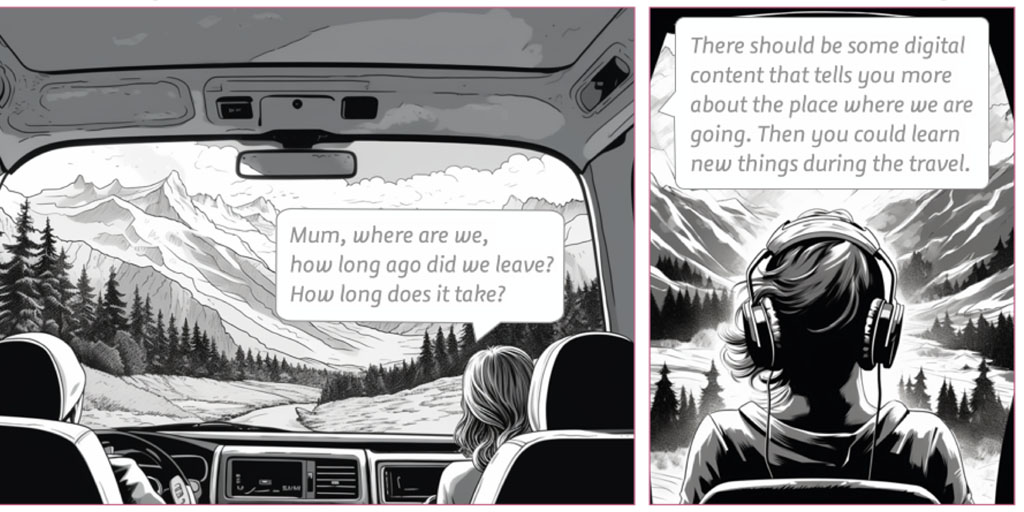
European car aesthetics: Unveiling preferences and values Client confidential Share In a moment of transition in technology and in the use of cars, new players appear on markets with established automotive manufacturers to offer innovative solutions. But how can you understand habits, preferences and values of new customers in order to make your new solutions more attractive? An Asian automotive company asked Experientia to explore the aesthetic tastes and mobility habits of European consumers developing evidence-based market segmentation. 3 things to know Quali-quantitative study By combining these two approaches, researchers could first explore and statistically validate the aesthetic preferences and trends through a large quantitative analysis, and then gain a deeper and more detailed understanding via a focused qualitative investigation. Personas, scenarios and VLOGs Quantitative survey and qualitative interviews categorized insights by assessing participants across dimensions like aesthetic taste, innovation openness, and choice drivers resulting in 12 personas. These personas were then linked to different scenarios, enabling a deeper exploration of individual attitudes and complexities. Additionally, 4 participants create 10-minute videos showcasing city life and aesthetics of 4 European cities, providing an intimate perspective on local culture and preferences. Large scale investigation The first part of the study was conducted on a large sample of participants across 10 European countries, while the second part involved a more detailed investigation in 4 of these countries conducted by local researchers. All the investigations were carried in the native language of each country. Gallery Car scenarios Car Persona – The sporty luxury lover Car 12 Personas Car aesthetic preferences Car Personas – love nest In depth Service mix: Design thinking Service design Ethnography Useful links: Link External link Context A major Chinese auto manufacturer was looking to expand its presence in the European market. To achieve this, they have commissioned Experientia to conduct a comprehensive study that focuses on exploring evolving preferences and environmental influences that shape the future lifestyle and aesthetic trends of mature automobiles among Europeans. Challenge The objective was to achieve a comprehensive understanding of potential European customers, exploring differences rooted in demographics as encompassing cultural backgrounds and personal aesthetic values. Research The first project phase included a quantitative survey, conducted with 300 individuals each in 10 European countries The second phase comprised qualitative research involving 20 interviews with five participants from four countries, conducted in the local language and complemented with city tours to deepen understanding of local culture and environments. The survey and interviews explored users’ aesthetic preferences and daily experiences. Design The gathered data enabled valuable modeling for product design, resulting in 12 personas defined by aesthetic preferences for cars and everyday items, as well as by lifestyle, demographics, mobility and purchase habits. Six scenarios highlighted each personas’ motivations and concerns about cars, while four vlogs portrayed mobility experiences of vloggers in four cities. These vlogs served to provide an aesthetic representation of diverse neighborhoods within four European cities. The intention was to offer aesthetic evidence of the urban environments, with the specific purpose of informing the design of products that will be tailored for these markets. Impact The results will be the base to improve product offerings, and enhance marketing strategies. Link External link Related projects All Services Behavioral design Research and assessment Strategy Consumer technology Buttonless: engaging users in interactions with keyless devices Consumer technology Mobile Privacy UX Consumer technology Customer experience insights to innovation Go back to our portfolio
Retail user experience for sustainable energy service
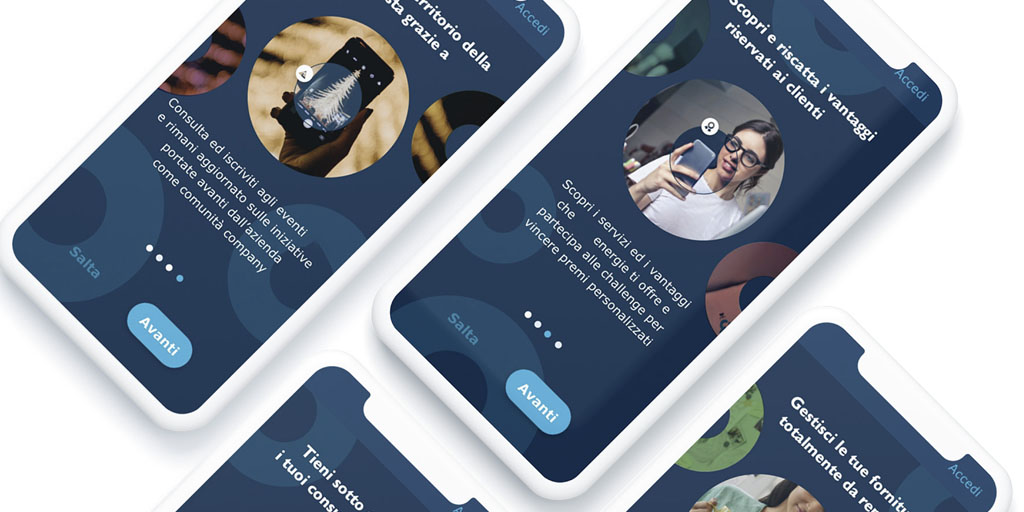
Retail user experience for sustainable energy service Client confidential Share Understand rising customer expectations of energy providers to deliver innovative, personalized and omnichannel customer experiences for an energy company with a focus on renewable energy. 3 things to know Understand the energy market Experientia interviewed energy experts and users with different levels of experience. This allowed us to understand people’s habits, sources of information, and the online platforms currently most used. The emphasis was on sustainable and environmental developments and technologies. Identify opportunities Participatory activities with users and client allowed us to identify opportunities and outline three concepts, all considered for further development. Each of the concepts will result in a digital touchpoint for users to inform better customer decisions in the energy market by sharing tips and suggestions in matters of sustainability and energy usage. Involve users in energy saving on the local level Experientia conducted a comprehensive communication analysis to highlight the need for a coherent and defined communication strategy, with a focus on environmental and sustainable energy aspects, in order to enable a greater focus on customer-centered energy services. Gallery Energie Report In depth Service mix: Design thinking Participatory design Service design Ethnography Useful links: Link External link Context A renewable energy company wants to expand its market towards retail customers, strengthening its presence on the Italian market in a context of continuous change in the energy sector. Challenge Facing growing environmental awareness, the client aimed to better understand the retail user experience to design an attractive, updated service offering and asked Experientia for support in this challenge. Research Experientia conducted desk research on competitors’ energy services, analyzed relevant case studies and interviewed energy experts (including individuals ranging from architects, urban experts, and similar professionals) in order to shape an extensive trend research and identified strategic market opportunities for the client. These experts were carefully selected to bring diverse perspectives and insights into our research efforts. The Experientia team also conducted qualitative user interviews in order to understand (potential) customer behaviors and their gain/pain points to map and evaluate the user experience. The in-depth interviews allowed us to investigate the research question from a wide, comprehensive perspective. Model and Design Experientia utilized findings from the research to frame and define opportunities. The team conducted participatory activities to outline new design concepts. Through sharing sessions and participatory activities we validated and prioritized the opportunities emerged from the research, to develop ad hoc solutions for the client and its targeted users. In parallel, the entire research activity involved also analyzing company’s communication to identify weaknesses and opportunities to build a consistent communication strategy. Impact The results of the project allow to shape 3 main concepts linked to potential solutions to be implemented in the following phase. The team identified standard services, energy market touch-points, ideas, and best practices that inspired the design phase, working alongside with project key stakeholders to brainstorm and develop potential solutions to attract new retail customers. After thorough evaluation and consideration, the client team selected these concepts to be developed in a second of the project, now ongoing. This strategic decision demonstrates our client’s commitment to implementing innovative solutions and underscores the value of our collaborative approach in shaping the project’s future direction. Link External link Related projects All Services Behavioral design Research and assessment Strategy Brand UXConsumer technology European car aesthetics: Unveiling preferences and values Brand UXConsumer technology Mobile Privacy UX Brand UX Qualitative research on food and drink consumption to develop new consumer services Go back to our portfolio
Rare disease patient journey mapping
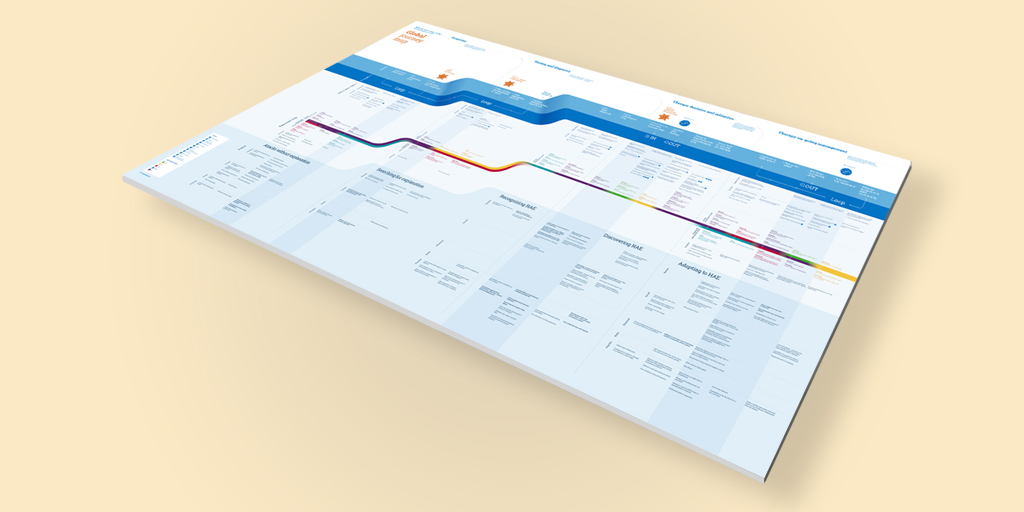
Rare disease patient journey mapping Client confidential (pharmaceutical company) Share A global-to-local approach to represent the patient experience. 3 things to know A toolkit that guaranteed quality and consistency of patient journey mapping process We aimed at redesigning the patient journey maps so they would look consistent throughout the different medical areas of the company and therefore improve usability. Patient experience and emotions at the center We gathered reports from many departments, both medical and commercial and grouped key patient insights in one reference file. At a glance you can gain a good understanding of the patient experience, emotions, behaviors and actions. Face-to-Face validation sessions with cross functional client teams Being able to gather feedback first hand from the expert teams as well as bringing them together in a room has opened up the possibility for great collaboration and future development opportunities. Gallery In depth Service mix: Business strategy design Participatory design Service design Behavioral modeling Ethnography Context Modern pharma companies need to align teams worldwide around a shared global patient journey to guide coherent service design and implementation. This global-to-local approach supports independent, local innovation by providing a shared, global representation of the patient experience, facilitating the company’s patient-centric approach through user-centered design. Challenge This four-month collaboration with the Global Patient Services team of the pharmaceutical company included desk research, journey map information architecture and visual design, pilot testing of a custom localization toolkit, and global patient journey in three local country offices, and iteration for global distribution. Research Our researchers read and evaluated numerous ethnographic research reports, market research summaries, and patient stories in the public domain. Analysis focused on determining the patient journey and distinguishing it from assumptions made from doctor, Pharma, and other stakeholder points of view. Design We developed a journey map representing the global patient journey from first symptoms through a lifetime of ongoing management of the disease. We then developed a “localization toolkit” – a workshop in a box – integrating bespoke activity templates and a recommended agenda to customize the global journey map and patient model to a country’s unique context. Impact Numerous teams have used journey mapping in the past, even for specific rare diseases. Our approach provided added value by integrating emotions, relationships, and the patient’s evolution over time. Designing a journey map of a multi-stakeholder process is the tip of the iceberg. Significant critical design and communication efforts were focused on communicating the impact of switching from a therapy to patient point of view. Related projects All Services Behavioral design Research and assessment Strategy Health GoCare: Interactive dashboard for a better home hospitalization service HealthSocial innovation Singapore: a city for people aging gracefully FinanceHealth XME Salute: integrating insurance offerings with wellness and health practices Go back to our portfolio
Banca 5, a new branchless bank model
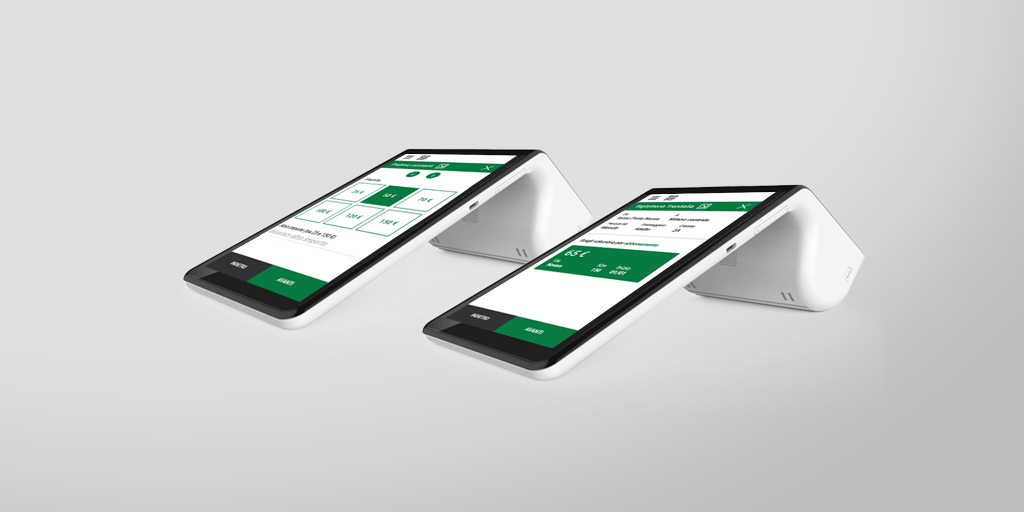
Banca5, a new branchless bank model Intesa Sanpaolo bank Share Experientia conducted an analysis of everyday transactions in the tobacconist’s shop, and defined interfaces and processes for a new Point of Service (POS). 3 things to know When digital banking is not sufficient The main problem that big banks have today is to allow non-digital customers (by age, education, internet access, …) to easily access the simplest banking services. Taking the branch out of the branch The aim of the project was to facilitate interaction with a manager outside the context of a branch. To do so, the main features of the banking network (sense of trust and protection, problem-solving capacity) need to be kept outside the bank. A non-invasive solution In parallel, we proposed a solution to the tobacconist network that is easy to learn and use, able to reduce the time of individual operations, and minimize the error ratio. In this way, the solution was accepted by the network and was immediately used. Gallery In depth Service mix: Information architecture Ethnography Context In the last ten years, about a third of bank branches in Italy have been closed. Banks have leveraged the new opportunities provided by technology, but for some sections of the population or in special cases computers and smartphones are not enough. Banca5 was created on the initiative of Intesa Sanpaolo to meet all customers who need to interact with a person to carry out simple operations (such as payments): distributed over a network of about 15,000 tobacconists, it allows the bank’s customers to carry out operations without going to the branch. Tobacconist shops in Italy do not only provide tobacco products in various forms, but also public transport tickets, lottery products, mobile phone top-ups, utilities bill payments, and stationery. In some cases they also have a bar. Challenge In 2019, Banca5 planned to upgrade POS terminals with screen and keyboard to an Android SmartPOS model the size of a phone. To make the transition effective, Experientia was involved as interaction design experts in the research and definition of the new user experience. We conducted a research on Banca5’s existing devices and analyzed the use routines of tobacconists, in order to highlight painpoints and requirements, also compared to the terminals of the competition (Lottomatica and Sisal). Research The observations at the tobacconist shop were functional to redefine the terminal’s UX (flow and information architecture) and to intercept aspects of the tobacconist’s experience. It allowed us to define priorities and needs useful for pursuing the Bank’s strategic objectives. Design TWe supported Banca5 in the complete redesign of the new device : the project was conducted in three iterations of prototyping and testing (all in Agile), in order to verify the solution with users as it was implemented. Impact The new terminal was launched in mid-2019 and was quickly adopted by some 2,000 tobacconists: intensive work and testing allowed POS interactions to be effectively transferred to a five-inch screen, minimizing error-rate and further speeding up the way tobacconists work. Related projects All Services Behavioral design Research and assessment Strategy Consumer technologyFinance BancoSmart, an award-winning ATM Finance CSA: sentiment-based decision support platform for crypto-currency trading FinanceHealth XME Salute: integrating insurance offerings with wellness and health practices Go back to our portfolio
GoCare: Interactive dashboard for a better home hospitalization service
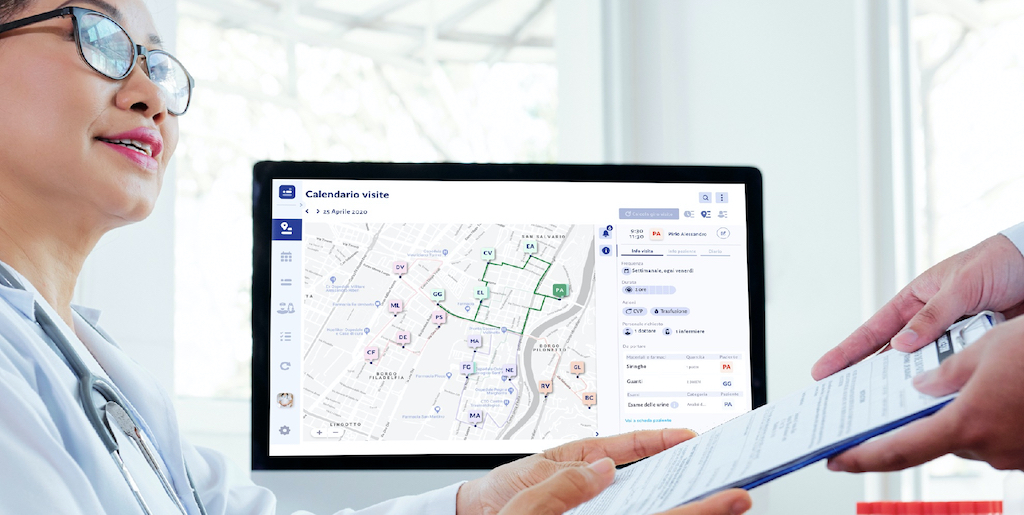
GoCare: Interactive dashboard for a better home hospitalization service CANP European Research Project Share In the context of the European research project CaNP* (“Casa Nel Parco”), Experientia conducted qualitative interviews, shadowing activities and participatory workshops to identify weaknesses and opportunities to improve the home hospitalization service of Molinette di Torino. Based on this research, the GoCare interactive dashboard was designed and validated. (* application 320-12 with co-financing of POR FESR Piemonte 2014-2020) 3 things to know Easier and faster visit management GoCare helps healthcare professionals to significantly reduce time spent on planning the schedule of visits, by analyzing and cross-referencing the relevant data – including patient priority and complexity, geolocation, and the healthcare staff’s shift. Improved communication between stakeholders Communication between caregivers and medical staff is facilitated through simultaneous access to a shared information center with visit schedules and patient monitoring. Data driven decision making The platform provides digital assistance and data to make daily decisions, just a click away. Gallery In depth Service mix: Prototyping Information architecture Participatory design Service design User experience testing Ethnography Context In the context of the European research project CaNP (“Casa Nel Parco”), Experientia conducted qualitative interviews, shadowing activities and participatory workshops to identify weaknesses and opportunities to improve the home hospitalization service of Molinette di Torino. Based on this research, the GoCare interactive dashboard was designed and validated. The prototype facilitates the planning of healthcare staff visits to patients’ homes, improves communication between staff, patients, and healthcare professionals, and manages contingencies, and better use of resources. The GoCare prototype of the CANP European research project (Question 320-12) was created thanks to the co-financing of the POR FESR Piemonte 2014-2020. It was implemented in the context of the Piedmont FESR 2014/2020 Regional Operational Program, in particular the “Health and Wellness” Technological Platform. functional technologies for the implementation of s3 strategies (Call Code: I.1b.2.2) Challenge Home hospitalization services offer an alternative to traditional hospitalization for patients in the acute phase of the disease. Active in Piedmont, since 1985 at AO CSST, it is dedicated to patients with geriatric and metabolic bone diseases. Experientia has designed a digital platform with the aim of facilitating the planning of visits by healthcare professionals to patients’ homes, improving communication between staff, patients and healthcare professionals, optimizing the management of contingencies and the use of resources. Research Experientia conducted interviews and analysis of the tasks within the OAD of Molinette and Cresla of Novara. The interviews provided useful details and requirements. Case studies on the best practices of similar services on a global scale, digital platforms, information structure and visual design were also researched. Critical points and opportunities emerged from the analysis. Design The conception phase subsequently allowed to develop a concept of a digital platform. This concept was designed, starting from the analysis and evaluation of activity flows, user paths and the creation of a detailed service model. Starting from the hi-fi wireframe screen design of the digital platform, the Experientia team created a design system and a visual reference (visual UI) and developed a click-through prototype, iterating based on the initial feedback received from the experts. Impact A study conducted by the University of Turin estimated that, if the platform were implemented in the current OAD department of the Molinette hospital, healthcare personnel would save up to 90-120 minutes a day used today to plan daily visits and 180 minutes per day today used to update paper documents. Related projects All Services Behavioral design Research and assessment Strategy Health Rare disease patient journey mapping HealthSocial innovation Singapore: a city for people aging gracefully FinanceHealth XME Salute: integrating insurance offerings with wellness and health practices Go back to our portfolio
ToNite: social innovation and urban regeneration in Turin, Italy

ToNite: social innovation and urban regeneration in Turin, Italy EU’s Urban Innovative Action Program Share ToNite is an urban renewal project which aims to develop multidisciplinary solutions to manage public spaces and improve residents’ perception of security at night-time along the Dora River of Turin, Italy. 3 things to know Design ethnography and service design Experientia explored the current culture of security – with a focus on night-time – in two different areas along the Dora River through the involvement of key stakeholders, local communities and citizens. The ethnographic research consisted of in-depth interviews, explorative urban walks and an online questionnaire. Co-design with communities During different phases of the project, citizens were given the opportunity to co-define solutions to improve social cohesion and the perception of night-time security and liveability of public spaces. Develop a human-centered approach to data modeling Evidence from research on the culture and perception of security was used to inform the design of the technology infrastructure that supported the City of Turin on related topics and defined a call for innovative local social impact projects. Gallery Video https://youtu.be/m7EpFn8RZJ8?si=7iWAp3KUGBcdV1lNhttps://youtu.be/eV2wwPIay0Y?si=JIWahAXLsptvIxMG In depth Service mix: Design thinking Policy development Participatory design Service design Ethnography Useful links: Download the report Italian language Link to ToNite website About the project Context Urban Innovative Actions (UIA) is a Program of the European Union that provides urban areas throughout Europe with resources to test new and unproven solutions to address urban challenges. Although research on urban issues is well developed, potential solutions are not always put into practice because urban authorities are reluctant to use their money to test new, unproven, and hence risky ideas. Urban Innovative Actions offers urban authorities the possibility to take a risk and experiment with the most innovative and creative solutions. The main objective of UIA is to provide urban areas throughout Europe with resources to test innovative solutions to the main urban challenges, and see how these work in practice and respond to the complexity of real life. ToNite was a 3-year project. It ran in the 2019-2023 timeframe. Challenge The City of Turin, together with a range of partners including Experientia, participated in the 2019 call and won a €4.6 million grant with a project called ToNite. ToNite sought to create urban regeneration and to address urban blight and decline in selected areas along the Dora River through collaborative policies based on social empowerment, active participation of residents and stakeholders, and social and technological innovation. The main project partner was the Municipality of Turin. Other partners were: Fondazione Piemonte Innova, SocialFare, Engineering, the European Forum for Urban Security, Espereal Technologies and ANCI (the National Italian Association of Municipalities). Research Experientia was particularly engaged in activating communities in exploration activities, defining areas of opportunities and requirements to facilitate civic empowerment and technology-based social sensing. This allowed the City of Turin to implement multidisciplinary and co-designed solutions to improve the livability of public spaces and the perceived security of our communities. Experientia conducted ethnographic and social enquiry activities in target neighborhoods, engaged key stakeholders to understand the current culture of security (with specific focus on the night-time experience), and defined 33 new opportunities for the City. More than 500 residents were involved in the project exploration phase. Both qualitative and quantitative research methods were adopted, including 36 in-depth interviews, 5 exploratory urban walks, and an online questionnaire. Research outputs were strategic in informing subsequent project phases. Both Opportunity Mapping and Persona Modelling were used to guide co-design processes for innovative and impact-oriented services for the target area. Design We supported project partners in working with communities to co-design opportunities for urban regeneration and services to improve social cohesion and the perception of security and liveability of public spaces at night-time. The results led the City of Turin in defining a call for innovative social impact projects. 19 impact-oriented and sustainable projects were funded and supported by dedicated acceleration programmes. Insights from our qualitative inquiry with citizens and city representatives also helped the team in developing an improved and integrated technology infrastructure to understand and analyze urban insecurity phenomena and to provide overall intelligence. Within the acceleration programme conducted by different partners, Experientia supported the projects in developing their service model with dedicated sessions and service design tools, delivering 19 Service Blueprints. The analysis of the overall ecosystem led to the co-definition of strategic guidelines for the City of Turin regarding the areas of intervention and priorities to develop and maintain a service ecosystem. Impact ToNite contributed to the physical regeneration of the Dora River, providing new urban furniture and regenerating unused spaces located in the area. The project intervened in two different areas along the Dora River with the aim was to understand and improve residents’ perception of night-time security and livability. The collaborative bottom-up process applied highlighted interventions, actions and services and models for residents and innovators. Download the report Italian language Link to ToNite website About the project Related projects All Services Behavioral design Research and assessment Strategy Social innovation Turin Public Libraries, redesigning the cultural experience Social innovation COE, Strengthening access to justice through non-judicial redress mechanisms HealthSocial innovation Singapore: a city for people aging gracefully Go back to our portfolio
Collaboration UI, redesigning the filter navigation experience
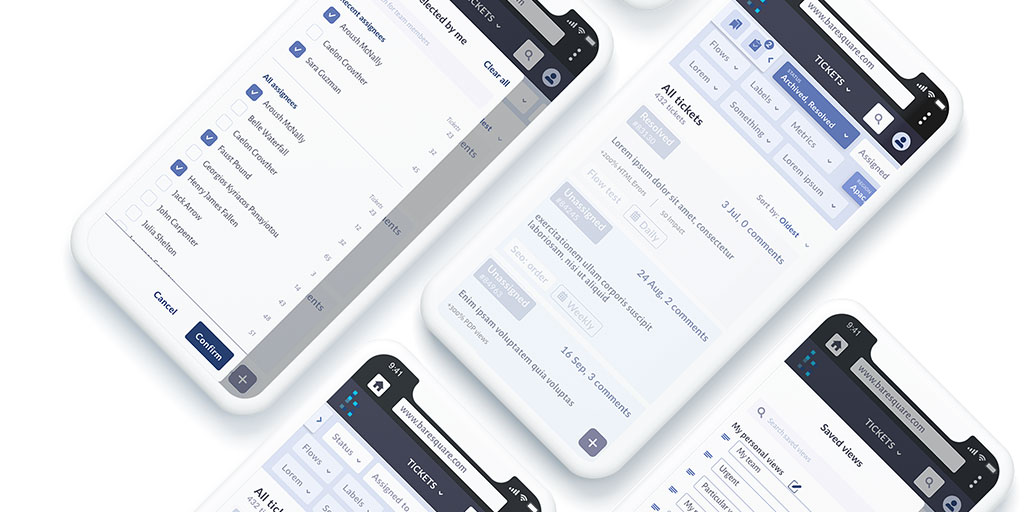
Collaboration UI, redesigning the filter navigation experience Baresquare Share Baresquare asked Experientia to identify the pain points of the current filtering experience of the Collaboration UI platform and to design an improved user interface. We investigated the current solution, deliver an interactive prototype and design specifications that offer optimized filter navigation experience. 3 things to know Co-desiging with the client on Miro boards Experientia carried out co-design workshop activities using remote visualization and collaboration tools. Co-design activities were managed using Miro boards and group video-calls, with stakeholders from different locations. Understanding multiple use cases and scenarios UI collaborations vary greatly depending on the context. The design team identified and developed solutions adaptable and scalable to variable use cases and future scenarios. Providing specific requirements We organized design specifications in Adobe XD, illustrating specific requirements for how the design should be executed. This includes dimensions, interaction patterns, ergonomic factors, aesthetic details (colors, fonts, and measurements of selected elements) and information (flows, behaviors and functionality). Gallery Stakeholder interviews Co-design Miro board Desk wireframes Hi-fi Prototype screens Design system In depth Service mix: Prototyping Information architecture Participatory design Context Baresquare is an International AI and data analytics company that developed Collaboration UI, an application enabling companies to multiply the efficiency of their teams and driving meaningful change in their business performance. Baresquare asked Experientia to identify the pain points in the UX of the Collaboration UI platform and to design an improved user interface that ensures an efficient, seamless, and pleasant interaction with the application. Challenge During the first 2 month “Sprint”, we worked with Baresquare to investigate the current solution via user interviews and a framing workshop, identified filter navigation best practices, and analyzed the competitor’s market. This allowed us to deliver an interactive prototype and design specifications that offered optimized filter navigation experience. In the second “Sprint” we focused on the redesign of the detailed ticket page and developed a new design system for desk and mobile app, providing clear direction and design specifications for an optimized color palette, typography, icon set, and main interactive components. Research Experientia conducted an in-depth analysis of the use of filters within the “collaboration UI” application. The analysis of the AS IS started with guided navigation tours, an heuristic review of the current UX/UI design according to Nielsen’s heuristics and interviews with tool users and stakeholders, to identify pain points and design opportunities. Fieldwork results and customer journey maps identified emerging themes ranging from platform usage, clients perspective, future vision and design opportunities. Based on these key findings, Experientia developed some alternative concepts and discussed these solutions during the remote framing workshop. Design Experientia iterated the selected concept and designed the look&feel of the user interface. We created a clickable prototype with an appealing visual design in Adobe XD. With the same tool we also provided specific requirements for how the design should be executed and created design specifications for the dev team of Baresquare. Related projects All Services Behavioral design Research and assessment Strategy B2B Reinventing customer and supplier interactions for a multinational flooring company B2B AR tools for industrial maintenance B2B Driving digital transformation one touch at a time Go back to our portfolio
Buttonless: engaging users in interactions with keyless devices
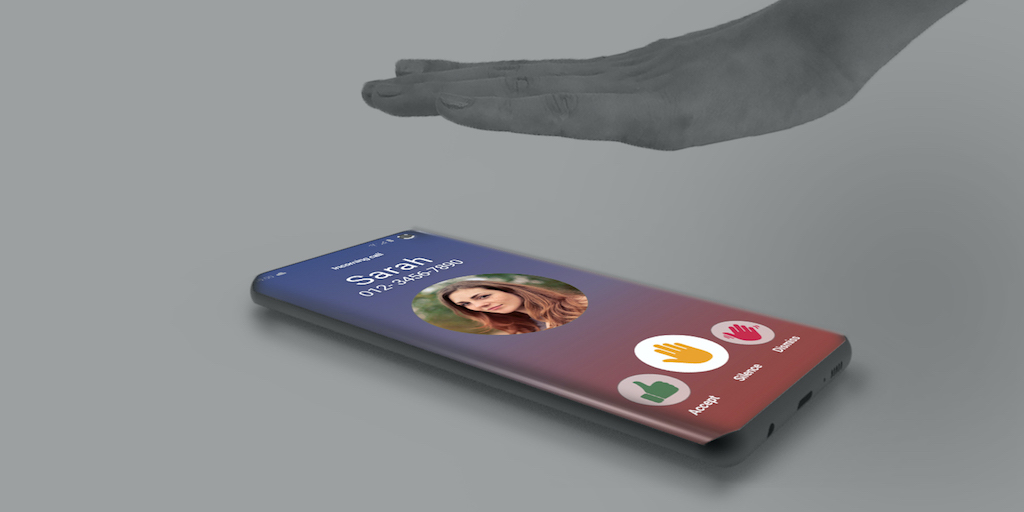
Buttonless: engaging users in interactions with keyless devices Samsung Share As we inch closer to phones with all-screen designs, physical buttons are on the chopping block. But how do you interact with a smartphone that has no buttons? Samsung asked Experientia to develop two navigation frameworks for a concept device. 3 things to know A new language Through extensive research, benchmarking, and the organization of a workshop with industry experts (incl. cognitive psychologists and UX specialists), a new language of interacting with a buttonless device was constructed, focusing not merely on isolated substitutes. From the workshop, two design challenges were identified and subsequently developed. The path to keyless strategy The strategy is based on analyzing the dynamic relationship between the user and the device, understanding that the device’s position significantly influences interaction (Edward T. Hall, ‘Proxemic’, 1968). By tracking user location and device handling, the device and its AI can anticipate user expectations and respond intelligently to various usage conditions. UX, UI and usability test The development of a functional physical prototype for a specific interaction was instrumental in augmenting the persuasiveness and efficacy of our design proposition. Moreover, Experientia conducted a usability test involving seven participants whose demographic characteristics aligned with potential international users of forthcoming Samsung flagship devices. This assessment centered on evaluating key aspects of the developed UX framework, thereby providing valuable insights into its usability and effectiveness. Gallery Benchmark Competitor Assessment Concept development Test User Test In depth Service mix: Envisioning Prototyping Information architecture User experience testing Useful links: Wired article External link Context Samsung, one of the world’s renowned communication companies, turned to Experientia to craft a tailored UX framework for the development of buttonless mobile solutions, encompassing both lateral and non-lateral interfaces. Challenge The task for Experientia was to cultivate a distinct language of interaction between users and their devices, fostering a seamless and intuitive user experience. Research The research process aimed to create user-centric UX navigation frameworks for buttonless devices. It started with market benchmarking and heuristic evaluations of alternative interaction methods, then an expert workshop identified key issues. Framework ideation led to tailored proposals, prototyped for validation. Design User testing gathered valuable insights, including changes in device handling under different conditions, universal gesture commands, and strategies for preventing user errors. This thorough research process informed the creation of user-centric UX navigation frameworks, ensuring a seamless and effective user experience. Impact The results of the project, center on establishing a symbiotic language between the device and the user. This language encompasses specific gestures and interaction cues designed to facilitate a seamless and harmonious collaboration between the user and the device, ultimately enhancing the overall user experience. Wired article External link Related projects All Services Behavioral design Research and assessment Strategy Brand UXConsumer technology European car aesthetics: Unveiling preferences and values Brand UXConsumer technology Mobile Privacy UX Consumer technology Customer experience insights to innovation Go back to our portfolio

